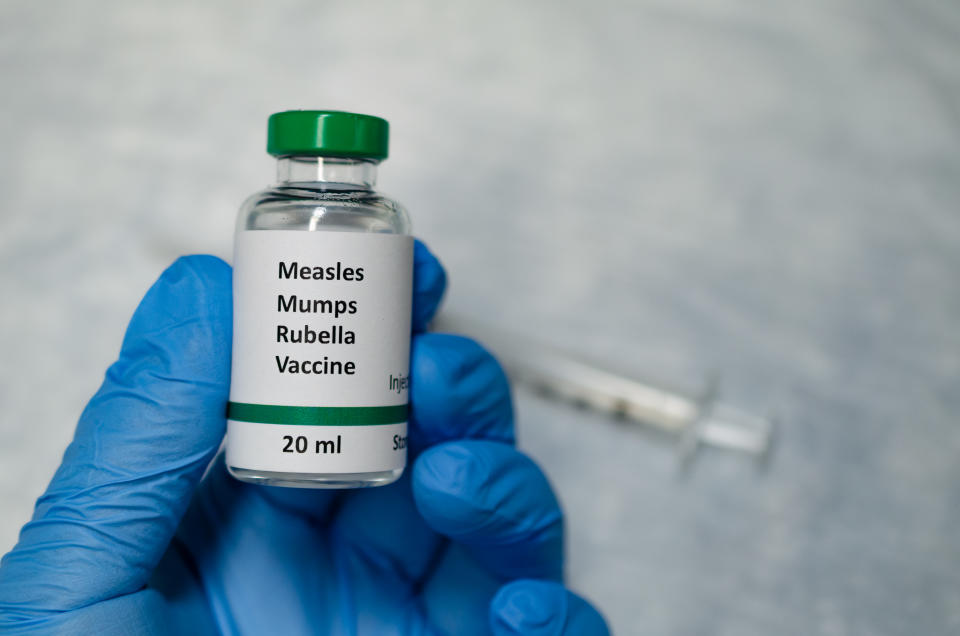Mumps hits decade high in England

Cases of mumps in England have reached a decade high, data shows.
The viral infection is defined by painful swelling in the side of the face under the ears, leading to a “hamster” appearance.
Most cases pass in a week or two with rest, fluids and painkillers.
Around one in seven sufferers, however, develop viral meningitis. Other complications include inflammation of the pancreas, testicles and ovaries.
Read more: Should we be concerned less children are having vaccines?
Outbreaks in universities and colleges led to 5,042 mumps cases in 2019, four times as many as 2018.
This is the highest cases have reached since 7,662 incidences were reported across England and Wales in 2009.
An outbreak occurred in 2005, resulting in 43,378 confirmed cases. This was put down to “gaps in eligibility” of the measles, mumps and rubella (MMR) jab.
Last month, 546 cases were confirmed in England, compared to 191 in January 2019, the Independent reported.
One Leeds University student reportedly needed morphine to cope with the pain, while another told the BBC her jaw “pretty much locked”.
Why is mumps on the rise?
The rise in cases has been blamed on falling uptake of the MMR vaccine.
The NHS offers the jab as part of its routine childhood immunisation schedule.
One dose is given when a child is around 12-to-13 months, and a booster at three years and four months.
Both doses are said to provide 95% protection against mumps.
NHS Digital data shows 94.5% of five year olds in England had been immunised with the first MMR dose in 2018/19, down from 94.9% in 2017/18 - both below the 95% immunisation target.
Even if not everyone has been vaccinated, having an immunisation rate of 95% can ward off an outbreak due to “herd immunity”.
Herd immunity means enough of the public have been vaccinated for an infection not to be able to “take hold”.
This protects those who may be unable to get vaccinated, like cancer or HIV patients.
When it comes to the second MMR dose, 86.4% of five-year-olds in England were immunised in 2018/19, down from 87.2% the year before.
Students struck with mumps likely missed out on the vaccine when they were children.
Read more: A third of parents think its okay to choose not to vaccinate their children against MMR
This may have coincided with the now discredited “research” from the then-gastroenterologist Andrew Wakefield, who mistakenly linked the MMR jab to autism.
This has repeatedly been dismissed, with Wakefield struck off.
The MMR vaccine is also said to be less effective at protecting against mumps than measles or rubella.
Nonetheless, four out of five people caught mumps before the jab was introduced in the UK in 1988, mainly school children.
Officials are urging those who missed out to get up-to-date on their vaccines.
“It is of concern we are seeing large numbers of cases of mumps,” said Professor Helen Bedford from University College London.
“These are mainly occurring among older teens and young adults who either had no doses of MMR vaccine when they were young or only had one dose.
“However, we also know the immunity from mumps vaccine can wane over time. This means you can still get mumps even if fully vaccinated.
“Although mumps can be nasty especially in people past puberty, it is usually much milder in previously-vaccinated people, so the best way to avoid mumps is to get the vaccine.
“If you haven’t been vaccinated, it’s never too late to have the MMR vaccine.”
Dr David Elliman, a consultant in community child health, added: “If someone is not sure whether they have had two doses of vaccine, they should go to their GP.
“No harm will come if they have extra doses.”

What is mumps?
As well as the tell-tale swollen face, mumps can trigger headache, joint pain and fever.
Many confuse these symptoms for glandular fever or tonsillitis.
The virus spreads like a cold or flu, via infected droplets of saliva inhaled by the nose or mouth.
The pathogen can also survive on hard surfaces, leading to contaminated hands.
Vaccination is the best protection against mumps.
Patients should wash their hands regularly, dispose of used tissues and stay at home for around five days after their symptoms start.
There is no specific cure for mumps, with treatment focusing on keeping the person comfortable while their immune system fights off the infection.
Most make a full recovery, however, complications can arise.
Read more: Your child's vaccination schedule: Each injection available - and what it does
Among boys who get mumps after puberty, a quarter develop painful swelling of the testicles, which passes in time.
Just under half of these males notice shrinkage to their testicles, while one in 10 have reduced sperm count, which is “very rarely large enough to cause infertility”.
In women who catch the virus after puberty, one in 20 experience swollen ovaries. This may present as lower abdominal pain, vomiting and fever.
This tends to resolve once the immune system has fought off the infection.
Around one in 20 cases of mumps triggers acute pancreatitis, short-term inflammation of the pancreas.
Often mild, patients may be admitted to hospital for support while they recover. Symptoms include pain in the centre of the abdomen, as well as vomiting, diarrhoea and possibly jaundice.
Viral meningitis is another relatively common complication. While it may sound alarming, cases caused by a virus are low risk. This is compared to bacterial meningitis, which is a life-threatening medical emergency.
Nonetheless, one in 1,000 who develop viral meningitis from mumps go on to get encephalitis, brain infection.
This is a potentially fatal condition, which killed around five people a year before the MMR vaccine was introduced.
Around one in 20 with mumps experience temporary hearing loss. Permanent hearing loss occurs in one in 20,000 cases.


